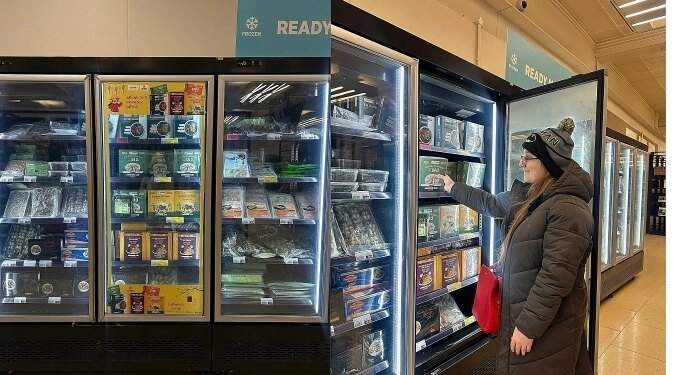Having lived in the U.S. for many years and frequently shopped at large supermarkets, Tina Murphy, CEO of MMTT Professional Services, said she is surprised by the limited availability of Vietnamese products.
 |
|
A customer looks at products at a retail store in the U.S. Photo courtesy of Ca Men |
They are mostly limited to Asian markets, she said at a recent forum.
“As a Vietnamese person, I find this concerning,”
In the first half of this year Vietnam’s exports of agricultural and aquatic products to the U.S. continued to post strong growth.
Coffee and fruits led with year-on-year growth rates of 76.4% and 65.5%, , according to data from the General Department of Customs.
Exports of aquatic products, pepper, rice, and confectionery also grew in double digits.
But retail industry analysts point out that Vietnam’s agricultural products are primarily exported in raw form, with processed and branded goods accounting for a low proportion.
Chris Nguyen, CEO of Ocean Marketing USA, says Vietnamese goods in the U.S. are mainly processed under contract manufacturing and lack a strong national brand unlike those of South Korea or Thailand, making market penetration challenging.
He blames this on manufacturers’ lack of resources and investment in branding, limited market understanding and absence of representatives in the U.S.
Other countries often have branches, agents or teams working on the ground, while Vietnamese businesses typically depend on importers themselves, he says.
Meeting quality, traceability and packaging requirements also poses a challenge for Vietnamese products.
Tony Luu, director of GPLUS – FDA, a U.S. company specializing in providing licensing and export support services for businesses, points out that on average two shipments of Vietnamese food products are rejected daily.
One main reason is their lack of compliance with U.S. Food Safety Modernization Act standards, he said.
Packaging errors are also common, such as missing or incomplete allergen information, incorrect nutritional facts formatting or product names not meeting regulations, particularly for seafood, he adds.
Jolie Nguyen, chairwoman of LNS International, a U.S. company which consults exporters in meeting international standards, says to improve access to major U.S. supermarkets, Vietnamese processed food exporters need to standardize production and packaging and comply with international trade laws.
She cautions against a short-term mindset of “producing quickly for quick sales” through informal channels like carrying by hand and small-scale trade as this could harm the reputation.
To facilitate formal trade, businesses should leverage export ecosystems to streamline market research, product pitching, compliance, and logistics, she adds.
Other insiders say that opportunities extend beyond the U.S.
Alejandro Gutierrez, growth director at Mexican company Guval Foods, which has long experience of taking Asian products to Mexico, began introducing Vietnamese foods to the market three or four years ago.
“Major chains like Walmart and Costco have directly asked for more popular Vietnamese products like rice paper and instant noodles,” he says.
Some Vietnamese businesses are proactively expanding.
Ca Men, a company that makes traditional frozen packaged foods like snakehead fish porridge and eel noodles, has recently expanded its export markets.
In June it started approaching over 50 supermarkets and distributors in Toronto, Canada.
It has been selling its products in California and Texas states in the U.S., Melbourne and Sydney cities in Australia and some locations in the U.K.
Recognizing that major supermarkets in the U.S., Australia, Canada, and the E.U. primarily use upright freezers, the company revamped its packaging, switching from flat packs to upright boxes for better display and accessibility.
Similarly, Sunrise Ins, besides exporting ST25 rice to the U.S., has taken this product to New Zealand and introduced rice paper, rice noodles and pho (noodle soup) to Mexico.
A company spokesperson said: “We’ve sent over 10 shipments to New Zealand and Mexico. In the case of rice paper, noodles and pho, we typically ship a 40-foot container every two or three months,”
Kim Hyo Gil, director of AFC & Foodil Global, a company connecting producers with buyers, says Vietnam’s agricultural and aquatic products are of high quality and competitively priced.
“Businesses should focus on the domestic market or the U.S. and consider expanding to the Middle East, Africa and South America.
On August 5 Foodil partnered with Vietnamese exporter LNS Group and the Asian Food Connect trade network in South Korea to launch the Foodil online wholesale food export platform in Vietnam.
The partners aim for this platform to be a new channel that enables food businesses to access over 30 markets.
A Foodil Vietnam spokesperson says on average a Vietnamese food producer spends $120,000 and one year to enter a new market.
But the platform’s integrated AI-driven logistics can significantly reduce the cost and time.





